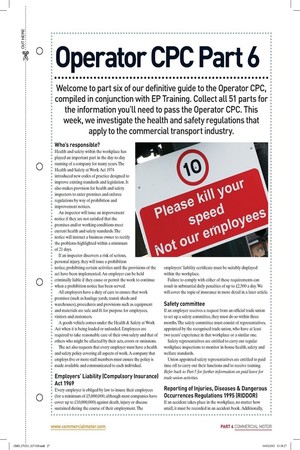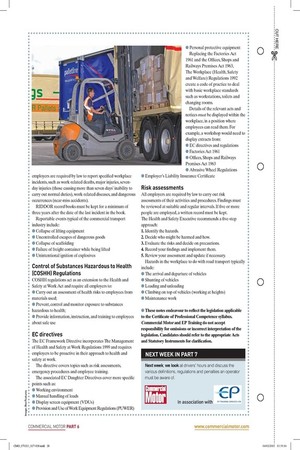erator CPC Part 6 Welcome to part six of our defin
Page 21

Page 22

If you've noticed an error in this article please click here to report it so we can fix it.
erator CPC Part 6 Welcome to part six of our definitive guide to the Operator CPC, compiled in conjunction with EP Training. Collect all 51 parts for the information you'll need to pass the Operator CPC. This week, we investigate the health and safety regulations that apply to the commercial transport industry.
Who's responsible?
Health and safety within the workplace has played an important part in the day-to-day running of a company for many years. The Health and Safety at Work Act 1974 introduced new codes of practice designed to improve existing standards and legislation. It also makes provision for health and safety inspectors to enter premises and enforce regulations by way of prohibition and improvement notices.
An inspector will issue an improvement notice if they are not satisfied that the premises and/or working conditions meet current health and safety standards. The notice will instruct a business owner to rectify the problems highlighted within a minimum of 21 days.
If an inspector discovers a risk of serious, personal injury, they will issue a prohibition notice, prohibiting certain activities until the provisions of the act have been implemented. An employer can be held criminally liable if they cause or permit the work to continue when a prohibition notice has been served.
All employers have a duty of care to ensure that work premises (such as haulage yards, transit sheds and warehouses), procedures and provisions such as equipment and materials are safe and fit for purpose for employees, visitors and customers.
A goods vehicle comes under the Health & Safety at Work Act when it is being loaded or unloaded. Employees are required to take reasonable care of their own safety and that of others who might be affected by their acts, errors or omissions.
The act also requests that every employer must have a health and safety policy covering all aspects of work. A company that employs five or more staff members must ensure the policy is made available and communicated to each individual.
Employers' Liability (Compulsory Insurance) Act 1969 Every employer is obliged by law to insure their employees (for a minimum of £5,000,000, although most companies have cover up to £10,000,000) against death, injury or disease sustained during the course of their employment. The employers' liability certificate must be suitably displayed within the workplace.
Failure to comply with either of these requirements can result in substantial daily penalties of up to £2,500 a day. We will cover the topic of insurance in more detail in a later article.
Safety committee If an employer receives a request from an official trade union to set up a safety committee, they must do so within three months. The safety committee must consist of representatives, appointed by the recognised trade union, who have at least two years' experience in that workplace or a similar one.
Safety representatives are entitled to carry out regular workplace inspections to monitor in-house health, safety and welfare standards.
Union appointed safety representatives are entitled to paid time off to carry out their functions and to receive training. Refer back to Part 5 for further information on paid leave for trade union activities.
Reporting of Injuries, Diseases & Dangerous Occurrences Regulations 1995 (RIDDOR) If an accident takes place in the workplace, no matter how small, it must be recorded in an accident book. Additionally, employers are required by law to report specified workplace incidents, such as work-related deaths, major injuries, sevenday injuries (those causing more than seven days' inability to carry out normal duties), work-related diseases, and dangerous occurrences (near-miss accidents).
RIDDOR record books must be kept for a minimum of three years after the date of the last incident in the book.
Reportable events typical of the commercial transport industry include: • Collapse of lifting equipment • Uncontrolled escapes of dangerous goods • Collapse of scaffolding • Failure of freight container while being lifted • Unintentional ignition of explosives Control of Substances Hazardous to Health (COSHH) Regulations COSI-1H regulations act as an extension to the Health and Safety at Work Act and require all employers to: • Carry out an assessment of health risks to employees from materials used; • Prevent, control and monitor exposure to substances hazardous to health; • Provide information, instruction, and training to employees about safe use EC directives The EC Framework Directive incorporates The Management of Health and Safety at Work Regulations 1999 and requires employers to be proactive in their approach to health and safety at work.
The directive covers topics such as risk assessments, emergency procedures and employee training.
The associated EC Daughter Directives cover more specific points such as: • Working environment • Manual handling of loads • Display screen equipment (VDUs) • Provision and Use of Work Equipment Regulations (PUVVER) • Personal protective equipment Replacing the Factories Act 1961 and the Offices, Shops and Railways Premises Act 1963, The Workplace (Health, Safety and Welfare) Regulations 1992 create a code of practice to deal with basic workplace standards such as workstations, toilets and changing rooms.
Details of the relevant acts and notices must be displayed within the workplace, in a position where employees can read them. For example, a workshop would need to display extracts from: • EC directives and regulations • Factories Act 1961 • Offices, Shops and Railways Premises Act 1963 • Abrasive Wheel Regulations • Employer's Liability Insurance Certificate Risk assessments All employers are required by law to carry out risk assessments of their activities and procedures. Findings must be reviewed at suitable and regular intervals. If five or more people are employed, a written record must be kept. The Health and Safety Executive recommends a five-step approach: 1. Identify the hazards.
2. Decide who might be harmed and how.
3. Evaluate the risks and decide on precautions.
4. Record your findings and implement them.
5. Review your assessment and update if necessary.
Hazards in the workplace to do with road transport typically include: • The arrival and departure of vehicles • Shunting of vehicles • Loading and unloading • Climbing on top of vehicles (working at heights) • Maintenance work • These notes endeavour to reflect the legislation applicable to the Certificate of Professional Competence syllabus. Commercial Motor and EP Training do not accept responsibility for omissions or incorrect interpretation of the legislation. Candidates should refer to the appropriate Acts and Statutory Instruments for clarification.








































